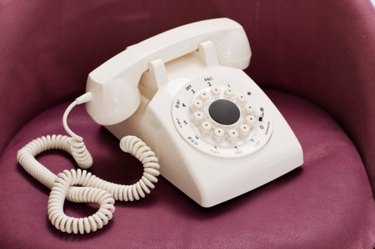
Even with the emergence of mobile communications, the landline phone is still a staple in voice communications. Almost every home and virtually every business has at least one landline phone installed. While most modern landline phone units feature a slew of additional features such as text messaging, video calling, mobility and dual line usage, these units still consist of pretty much the same parts as that of the antique rotary landline phones.
The Ringer
Video of the Day
The ringer or the signaling device is one of the most basic components in a landline phone. This device's objective is to alert the user of an incoming call. In the past, landline phones were fitted with a bell that produced a chime-like ring whenever an incoming call was apparent. Today, the ringer in most landline phone units consists of a speaker that would produce a digital melody or electronic tone. In some cases, these units may even be accompanied with an LED bulb that will light up along with the ringer, perfect to alert people with hearing difficulties.
Video of the Day
The Dialer
The old phones featured a rotary dialer that when rotated would produce pulses that interrupted the flow of the phone circuit. These interruptions were counted to determine the number dialed. The local phone exchange would then direct the call to the phone line with the assigned phone number dialed. Today, this system works in the same way. Rotary dialers have been replaced by keypads, and identifying the number dialed is based on tones instead of pulses. Each number on the dialer has a specific tone assigned.
The Switch
Landline phones are fitted with switches. In most units, these switches are typically called plungers and are located where the handset rests. When the plunger is pressed, the phone circuit is closed. When it is elevated, the circuit opens, allowing the user to make or receive a call, resulting in either a dial tone or the voice of the caller. Today, many landline units use an electronic on-and-off switch in lieu of a plunger.
The Handset
The handset is the piece of the phone that is held to the face, one end on the ear and the other on the mouth. The earpiece consists of an internal receiver that translates electronic signals into sound that a person can comprehend. On the other end of the handset is the mouthpiece, which consists of the transmitter. The transmitter is really a microphone that catches sound waves. The sound is then converted into electronic signals and sent through the exchange toward the other phone. Both these components are connected to a coil that prevents feedback and reduces the ambient noise.